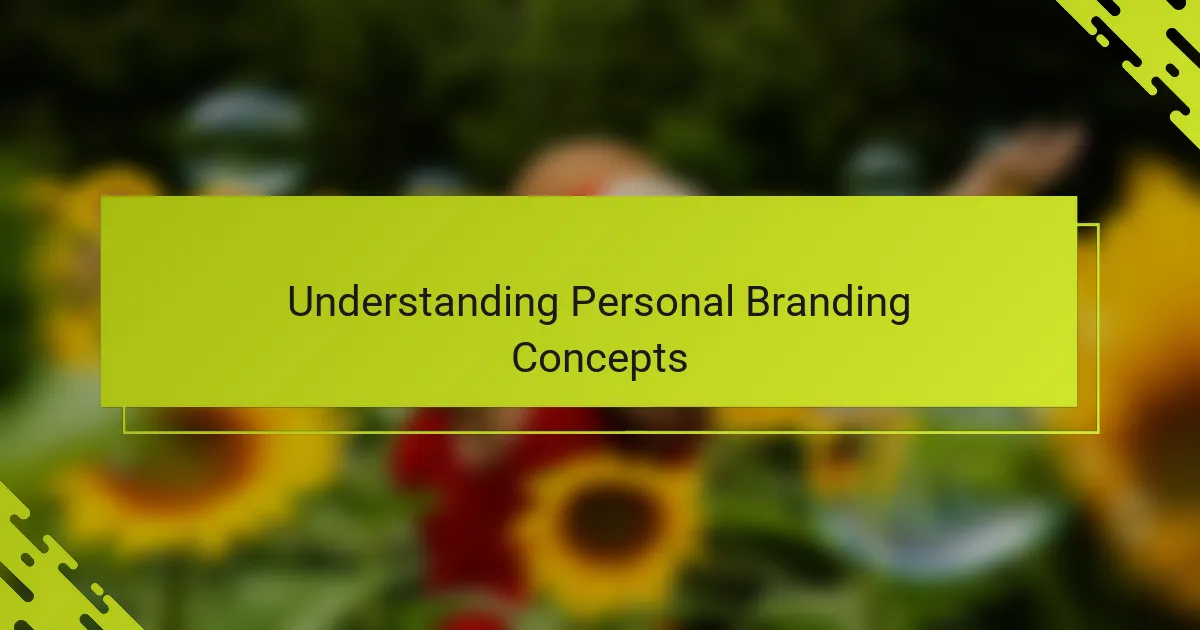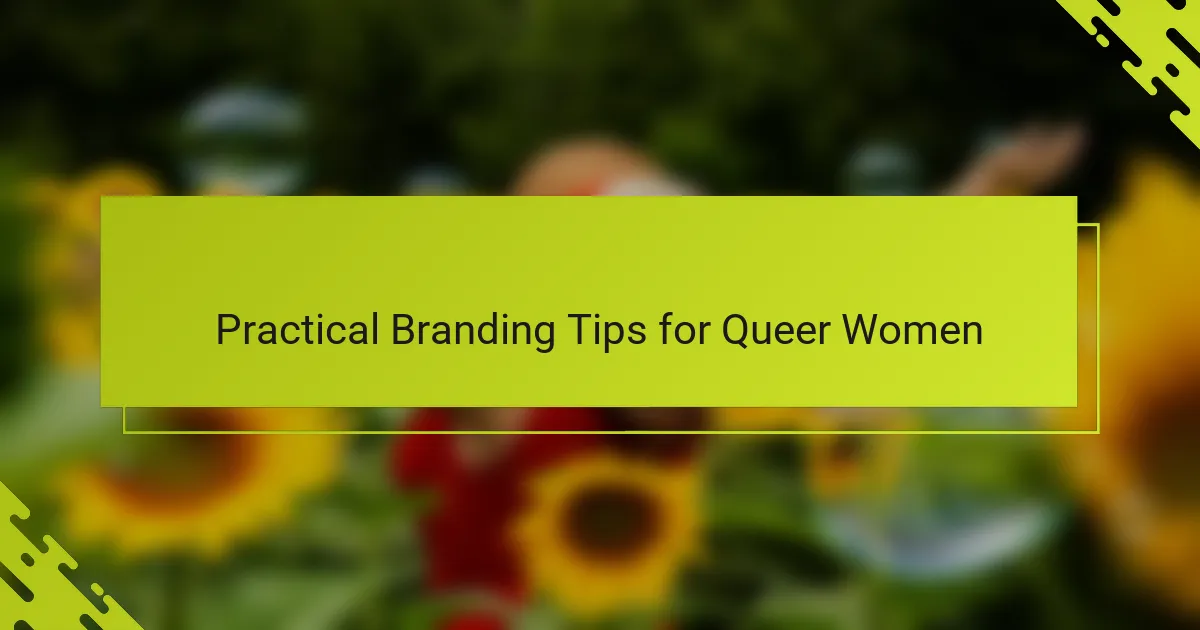Key takeaways
- Personal branding is centered around authenticity and understanding one’s core values, emphasizing the importance of starting with “why” as suggested by Simon Sinek.
- Vulnerability in sharing one’s motivations fosters genuine connections and builds trust within communities, particularly in queer culture.
- Branding should be a fluid and evolving process, allowing individuals to express their changing identities and growth over time.
- Empathy and listening are essential components of effective branding, creating a two-way dialogue that promotes inclusivity and belonging.

Understanding Personal Branding Concepts
Personal branding, to me, is about more than just a polished online profile or catchy slogans. It’s really about authenticity—showing up as your true self and making sure that the way you present yourself aligns with what you genuinely believe in. Have you ever felt like your public image didn’t truly reflect who you are inside? That mismatch can feel alienating, and that’s where Simon Sinek’s focus on starting with “why” resonates so deeply.
I recall a time when I struggled to define my own brand because I focused too much on what others expected rather than what inspired me personally. Sinek’s idea of leading with purpose helped me connect my story and values in a way that felt honest and empowering. It made me realize that personal branding is less about selling and more about communicating the meaning behind what you do.
When you think about it, shouldn’t personal branding create a sense of connection rather than distance? Exploring this thought made me appreciate how crucial it is to understand not just what we do, but why we do it—this understanding forms the core of any meaningful personal brand.

Overview of Simon Sinek’s Ideas
Simon Sinek’s core idea centers around the question: Why do you do what you do? It’s surprising how often we jump straight to what we do without understanding the deeper purpose behind it. For me, this perspective shifted everything about how I view personal branding—it’s about clarity of intention, not just actions or achievements.
One concept that really stuck with me is the Golden Circle, where Sinek explains that communicating from the inside out—starting with why, then how, then what—creates trust and loyalty. I remember applying this when I shared my own reasons for advocating within the queer women’s community; it felt vulnerable but also incredibly freeing to lead with my ‘why’ instead of just facts and labels.
Doesn’t it make sense that when we connect through purpose, others can see the real us beyond surface-level traits? Sinek’s emphasis on empathy and authenticity highlights how personal branding can be an invitation to belong, rather than a performance to impress. This has changed how I approach both my personal and professional relationships.

Exploring Queer Women Culture
Queer women culture, to me, is a vibrant tapestry woven from diverse identities, experiences, and expressions. Have you noticed how it challenges mainstream narratives by embracing fluidity and defying rigid categories? This culture offers a rich space where authenticity isn’t just valued—it’s essential.
I remember attending a small gathering where queer women shared stories not through labels, but through lived moments full of joy, struggle, and resilience. It struck me how deeply personal and communal this culture is; it thrives on connection and understanding rather than conformity.
What makes queer women culture so powerful is its ability to hold complexity without needing to simplify or explain away differences. It’s a reminder that identity isn’t a fixed point but an evolving journey—one that invites us to show up fully, exactly as we are.

Applying Sinek’s Principles in Queer Culture
Applying Sinek’s principle of starting with “why” feels especially poignant within queer culture, where identity and purpose often intertwine deeply. I’ve noticed that when queer women articulate their “why”—the passion or cause driving them—it creates a sense of belonging that goes beyond just shared labels. Doesn’t it feel more authentic to connect over core values than just identities?
In my experience, using the Golden Circle lens helps unpack the sometimes complex emotions behind queer narratives. It’s easy to focus on “what” we do or “how” we express ourselves, but diving into the “why” reveals powerful stories of resilience and hope. I once found that sharing my “why” invited others to see me as more than a checkbox or stereotype—it made space for genuine understanding.
Sinek’s ideas also highlight how vulnerability can be a strength within personal branding in queer communities. Have you ever felt hesitant to share your true story for fear of judgment? Leaning into honesty, as Sinek suggests, encourages not just self-acceptance but collective empathy. That’s something I see reflected every time queer women gather and support one another through purpose-driven connection.

My Personal Experience with Branding
There was a period when I felt like I was wearing a mask with my personal brand, trying so hard to fit into a mold I thought others wanted. It wasn’t until I embraced Simon Sinek’s idea of starting with “why” that I began to peel back those layers and share my true motivations. Have you ever had that moment when honesty unexpectedly opens doors to deeper connections? That shift made all the difference for me.
At one point, I experimented with crafting messages that reflected not just what I do, but why it matters to me. It felt scary at first—putting vulnerability out there—but what surprised me most was how warmly people responded to that honesty. In my experience, authenticity isn’t just a buzzword; it becomes a bridge to building trust and community.
I often wonder why so many of us hesitate to bring our whole selves to the forefront when personal branding offers such a powerful chance to be seen and understood. For me, living my brand aligned with my core has been a humbling journey but also incredibly liberating—a reminder that when you lead with purpose, you invite others to do the same.

Practical Branding Tips for Queer Women
When it comes to branding as a queer woman, I’ve found that clarity about your core values is everything. Ask yourself: what drives you beyond surface labels? For me, centering my “why” has made my brand feel honest, not performative. It’s about sharing your story in a way that invites others in rather than putting up walls.
I remember the first time I spoke openly about what truly motivates me—it was nerve-wracking but also deeply affirming. Have you ever felt that mix of vulnerability and strength that comes with being unapologetically yourself? Embracing that helped me build connections rooted in trust, not just identity. Practical branding, then, is really about choosing authenticity over perfection.
Another tip I’ve learned is to let your brand evolve with you. Identity within queer culture is fluid, so your brand doesn’t have to be a fixed script. I’ve noticed that when I’m willing to share my growth and changing perspectives, my community responds with understanding and support. Isn’t it freeing to think of your personal brand as a living story, not a static label?

Lessons Learned from Sinek’s Approach
What I find most striking in Sinek’s approach is the power of starting with “why” to create a personal brand that feels genuine and meaningful. Have you ever tried to explain what drives you at your core and noticed how that clarity instantly shifts how others relate to you? For me, this simple question peeled back layers of superficial self-presentation and revealed a deeper story worth sharing.
Another lesson I’ve come away with is how vulnerability, framed by purpose, can transform personal branding from a performance into an opportunity for real connection. I recall moments when opening up about my “why” felt risky, yet it invited empathy instead of judgment. Isn’t it incredible how showing your true motivations can build bridges rather than walls?
Lastly, Sinek’s emphasis on empathy teaches that personal branding is as much about listening and understanding others as it is about expressing yourself. When I embrace this balance, I feel my brand becoming a two-way conversation—a living dialogue that respects complexity and fosters belonging within queer communities. Doesn’t this make the idea of branding feel more human and inclusive?
